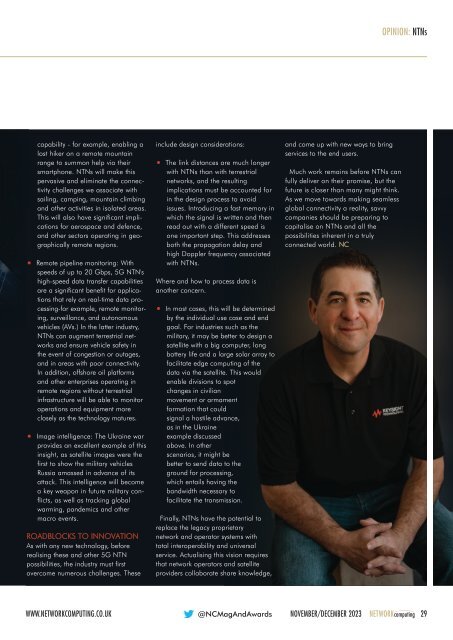NC Nov-Dec 2023
Create successful ePaper yourself
Turn your PDF publications into a flip-book with our unique Google optimized e-Paper software.
OPINION: NTNs<br />
<br />
<br />
capability - for example, enabling a<br />
lost hiker on a remote mountain<br />
range to summon help via their<br />
smartphone. NTNs will make this<br />
pervasive and eliminate the connectivity<br />
challenges we associate with<br />
sailing, camping, mountain climbing<br />
and other activities in isolated areas.<br />
This will also have significant implications<br />
for aerospace and defence,<br />
and other sectors operating in geographically<br />
remote regions.<br />
Remote pipeline monitoring: With<br />
speeds of up to 20 Gbps, 5G NTN's<br />
high-speed data transfer capabilities<br />
are a significant benefit for applications<br />
that rely on real-time data processing-for<br />
example, remote monitoring,<br />
surveillance, and autonomous<br />
vehicles (AVs.) In the latter industry,<br />
NTNs can augment terrestrial networks<br />
and ensure vehicle safety in<br />
the event of congestion or outages,<br />
and in areas with poor connectivity.<br />
In addition, offshore oil platforms<br />
and other enterprises operating in<br />
remote regions without terrestrial<br />
infrastructure will be able to monitor<br />
operations and equipment more<br />
closely as the technology matures.<br />
Image intelligence: The Ukraine war<br />
provides an excellent example of this<br />
insight, as satellite images were the<br />
first to show the military vehicles<br />
Russia amassed in advance of its<br />
attack. This intelligence will become<br />
a key weapon in future military conflicts,<br />
as well as tracking global<br />
warming, pandemics and other<br />
macro events.<br />
ROADBLOCKS TO INNOVATION<br />
As with any new technology, before<br />
realising these and other 5G NTN<br />
possibilities, the industry must first<br />
overcome numerous challenges. These<br />
include design considerations:<br />
<br />
The link distances are much longer<br />
with NTNs than with terrestrial<br />
networks, and the resulting<br />
implications must be accounted for<br />
in the design process to avoid<br />
issues. Introducing a fast memory in<br />
which the signal is written and then<br />
read out with a different speed is<br />
one important step. This addresses<br />
both the propagation delay and<br />
high Doppler frequency associated<br />
with NTNs.<br />
Where and how to process data is<br />
another concern.<br />
<br />
In most cases, this will be determined<br />
by the individual use case and end<br />
goal. For industries such as the<br />
military, it may be better to design a<br />
satellite with a big computer, long<br />
battery life and a large solar array to<br />
facilitate edge computing of the<br />
data via the satellite. This would<br />
enable divisions to spot<br />
changes in civilian<br />
movement or armament<br />
formation that could<br />
signal a hostile advance,<br />
as in the Ukraine<br />
example discussed<br />
above. In other<br />
scenarios, it might be<br />
better to send data to the<br />
ground for processing,<br />
which entails having the<br />
bandwidth necessary to<br />
facilitate the transmission.<br />
Finally, NTNs have the potential to<br />
replace the legacy proprietary<br />
network and operator systems with<br />
total interoperability and universal<br />
service. Actualising this vision requires<br />
that network operators and satellite<br />
providers collaborate share knowledge,<br />
and come up with new ways to bring<br />
services to the end users.<br />
Much work remains before NTNs can<br />
fully deliver on their promise, but the<br />
future is closer than many might think.<br />
As we move towards making seamless<br />
global connectivity a reality, savvy<br />
companies should be preparing to<br />
capitalise on NTNs and all the<br />
possibilities inherent in a truly<br />
connected world. <strong>NC</strong><br />
WWW.NETWORKCOMPUTING.CO.UK @<strong>NC</strong>MagAndAwards NOVEMBER/DECEMBER <strong>2023</strong> NETWORKcomputing 29
















